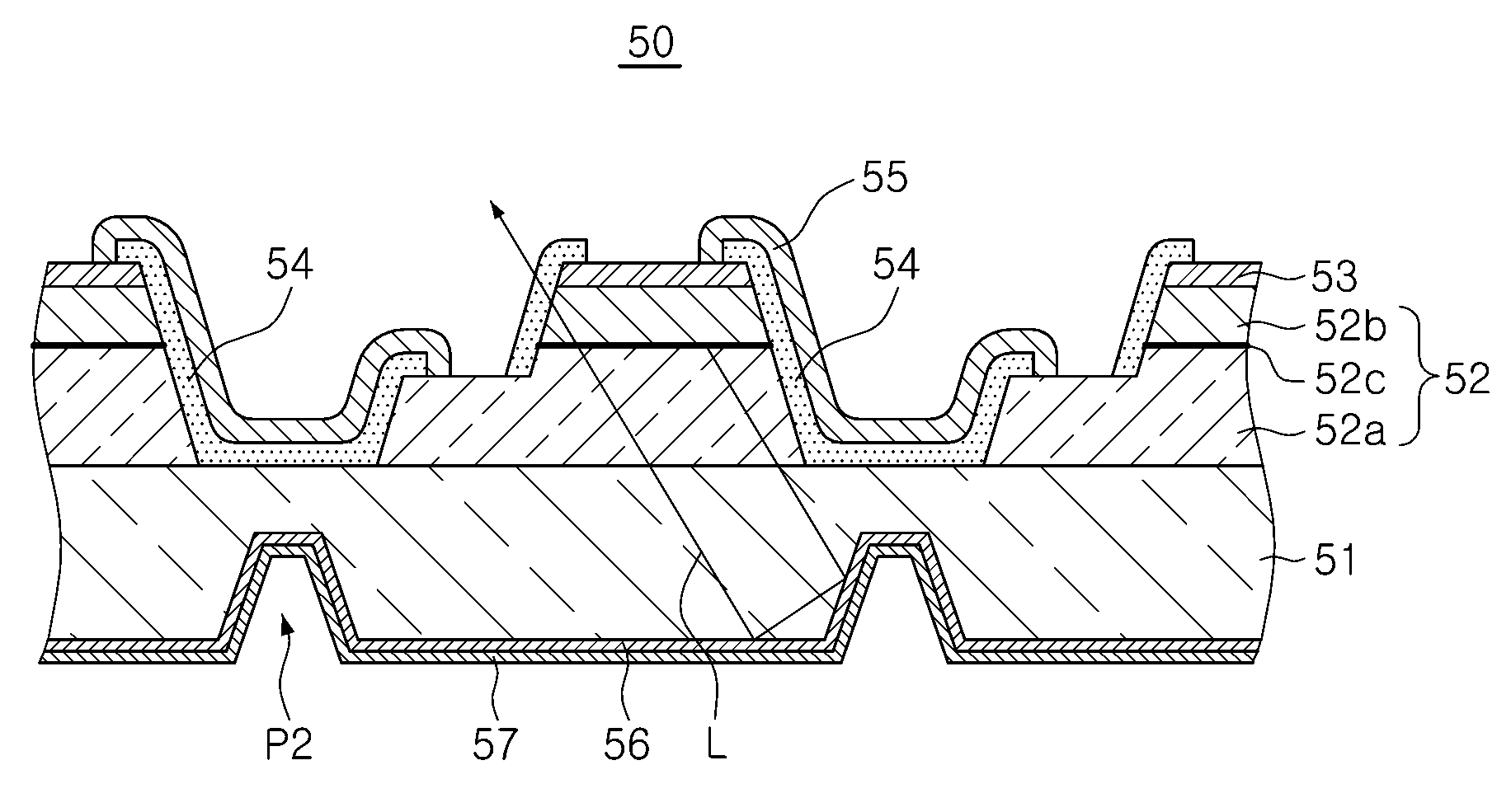Semiconductor light emitting device having multi-cell array, light emitting module, and illumination apparatus
a light-emitting device and semiconductor technology, applied in the direction of semiconductor devices, basic electric elements, electrical equipment, etc., can solve the problems of high-power leds using high-rated currents that have low light efficiency, accelerate light efficiency degradation, and reduce light efficiency, so as to improve light extraction efficiency, improve light efficiency, and improve current density per unit area
- Summary
- Abstract
- Description
- Claims
- Application Information
AI Technical Summary
Benefits of technology
Problems solved by technology
Method used
Image
Examples
first embodiment
[0056]FIG. 1 is a plan view illustrating an example (a complete isolation between cells) of a multi-cell array semiconductor light emitting device according to the present invention. FIG. 2 is an equivalent circuit diagram illustrating the connection between cells of the multi-cell array semiconductor light emitting device illustrated in FIG. 1. FIGS. 3A and 3B are side sectional views of the multi-cell array semiconductor light emitting device illustrated in FIG. 1, which are taken along lines A1-A1′ and A2-A2′ of FIG. 1.
[0057]Referring to FIGS. 1 and 3A, a multi-cell array semiconductor light emitting device 10 according to a first embodiment of the present invention includes a substrate 11, and a plurality of light emitting cells C arrayed on the top surface of the substrate 11.
[0058]The light emitting cell C is obtained by dividing, through an isolation process, a semiconductor multilayer structure 12 having a first-conductivity-type semiconductor layer 12a, an active layer 12c,...
second embodiment
[0104]FIGS. 8A and 8B are cross-sectional views illustrating various examples (a complete isolation between cells) of a multi-cell array semiconductor light emitting device according to the present invention.
[0105]Unlike the embodiment illustrated in FIGS. 3A and 3B, this embodiment provides a scheme for applying a reflection member to the isolation region.
[0106]The structure illustrated in FIG. 8A corresponds to the region of A2-A2′ in the multi-cell array semiconductor light emitting device having a similar array to FIG. 1.
[0107]Referring to FIG. 8A, a semiconductor light emitting device 80 includes a substrate 81, and a light emitting cell having a semiconductor multilayer structure 82 formed on the substrate 81.
[0108]The semiconductor multilayer structure 82 has a first-conductivity-type semiconductor layer 82a, an active layer 82c, and a second-conductivity-type semiconductor layer 82b that are sequentially stacked on the substrate 81.
[0109]As illustrated in FIG. 8A, a reflecti...
third embodiment
[0138]FIG. 12 is a plan view illustrating an example of a multi-cell array semiconductor light emitting device according to the present invention. FIG. 13 is an equivalent circuit diagram of the multi-cell array semiconductor light emitting device illustrated in FIG. 12.
[0139]Referring to FIG. 12, a multi-cell array semiconductor light emitting device 120 includes a substrate 121, and a plurality of light emitting cells C arrayed in a 6×6 pattern on the top surface of the substrate 121.
[0140]The light emitting cell C is obtained by dividing a semiconductor multilayer structure 122 having a first-conductivity-type semiconductor layer 122a, an active layer 122c, and a second-conductivity-type semiconductor layer 122b that are sequentially formed on the top surface of the substrate 121.
[0141]In this embodiment, the isolation process is performed through a complete isolation process that completely removes the semiconductor multilayer structure 122 to expose the surface of the substrate...
PUM
 Login to View More
Login to View More Abstract
Description
Claims
Application Information
 Login to View More
Login to View More - R&D
- Intellectual Property
- Life Sciences
- Materials
- Tech Scout
- Unparalleled Data Quality
- Higher Quality Content
- 60% Fewer Hallucinations
Browse by: Latest US Patents, China's latest patents, Technical Efficacy Thesaurus, Application Domain, Technology Topic, Popular Technical Reports.
© 2025 PatSnap. All rights reserved.Legal|Privacy policy|Modern Slavery Act Transparency Statement|Sitemap|About US| Contact US: help@patsnap.com



